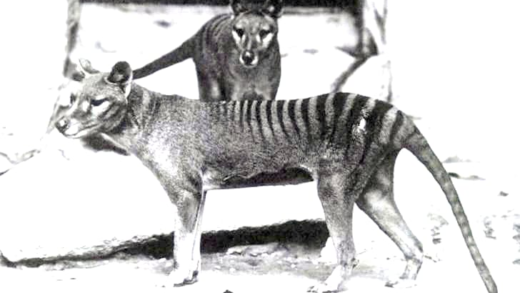Marsupial lions, unique apex predators of the Pleistocene, faced extinction due to climate change, human competition, habitat loss, and prey depletion. Their hunting methods resemble modern ambush tactics seen in tree-climbing cats and other predators, showcasing a fascinating continuity of behaviors across species.
What Were Marsupial Lions?
Marsupial lions, also known as Thylacoleo, were unique carnivorous marsupials that roamed Australia during the Pleistocene epoch, approximately 1.6 million to 46,000 years ago. These fascinating creatures were not true lions but were more closely related to modern-day koalas and wombats. With their powerful build, sharp teeth, and retractable claws, marsupial lions were apex predators of their time.
Characterized by their robust skeleton and large jaw structure, they adapted well to their environment, dominating the ancient ecosystems. Unlike today’s lions, marsupial lions had a unique reproductive system, carrying their young in pouches similar to other marsupials. This fascinating evolutionary trait helped them thrive in the diverse habitats of prehistoric Australia.
Hunting Methods of Marsupial Lions: A Different Approach
The hunting methods of marsupial lions significantly differed from those of modern predators. While contemporary big cats often rely on speed and stamina to chase down prey, marsupial lions employed a more ambush-style approach. They likely used their powerful limbs and strong claws to climb trees and wait for unsuspecting prey to wander by.
This hunting strategy allowed them to surprise their victims, a technique that required patience and stealth. Their robust jaws and sharp teeth were ideal for crushing bones and tearing flesh, enabling them to feed on larger animals that other predators might avoid. By targeting large herbivores such as giant kangaroos and wombats, marsupial lions showcased their adaptability and prowess as hunters.
Techniques Used by These Ancient Carnivores
Marsupial lions utilized several unique techniques in their hunting repertoire. One notable method was their ability to leap onto prey, thanks to their powerful hind legs. This allowed them to quickly close distances, making them formidable hunters.
Moreover, they likely used their keen sense of smell to detect prey from afar, similar to modern carnivores. Their hunting techniques included:
- Ambush Predation: Waiting quietly in vegetation or trees.
- Powerful Climbing: Utilizing trees for a better vantage point.
- Bone-Crushing Jaws: Capable of breaking through tough hides and bones.
These methods highlight the evolutionary adaptations that allowed marsupial lions to thrive in their environment, showcasing their role as top predators in ancient Australia.
Why Their Hunting Style is Considered ‘Weird’
The hunting style of marsupial lions is often deemed ‘weird’ due to its stark contrast with the methods of modern predators. Unlike contemporary big cats that rely heavily on speed and stamina, marsupial lions showcased a more stealthy and ambush-oriented technique. This unique approach involved waiting patiently, often in trees or dense vegetation, to surprise their unsuspecting prey.
Moreover, their powerful build and bone-crushing jaws made them capable of tackling larger prey than most modern hunters. They were not built for long chases; instead, their strength lay in their ability to pounce effectively from a hidden position. This hunting style can seem unusual when compared to the relentless pursuit seen in today’s carnivores, making marsupial lions a fascinating study in evolutionary adaptation.
Types of Prey Marsupial Lions Targeted
Marsupial lions primarily hunted large herbivores that roamed the ancient landscapes of Australia. Their prey included a variety of animals, notably:
- Giant Kangaroos: These large, agile creatures provided a significant source of food.
- Wombats: With their tough hides, wombats were a challenging but rewarding target.
- Other Marsupials: They also preyed on smaller marsupials when the opportunity arose.
Their hunting techniques allowed them to take down larger animals, showcasing their role as apex predators. By targeting these herbivores, marsupial lions played a crucial role in maintaining the ecological balance of their environment.
Environmental Impact of Marsupial Lions
The presence of marsupial lions had a significant impact on their environment. As apex predators, they influenced the populations of large herbivores, which in turn affected vegetation growth and biodiversity. Their unique hunting methods, particularly their ambush tactics, likely allowed them to maintain a balance in the ecosystem.
By preying on large animals, they prevented overgrazing and helped sustain healthy plant communities. However, their extinction also led to noticeable changes in the environment. Without these top predators, herbivore populations may have surged, leading to increased pressure on plant life and altering habitats across Australia. This shift illustrates the vital role marsupial lions played in shaping their ecological landscape.
Factors Leading to Their Extinction
Marsupial lions faced several significant challenges that led to their extinction around 46,000 years ago. The primary factors contributing to their decline included:
- Climate Change: As the Pleistocene epoch transitioned into warmer periods, habitats altered dramatically. Many species that marsupial lions relied on for food, such as giant kangaroos and other large herbivores, faced their own struggles due to changing climates, which ultimately reduced prey availability.
- Human Activity: The arrival of humans in Australia likely posed a severe threat to marsupial lions. As early humans hunted large animals for food, the competition for resources intensified, diminishing the population of both prey and apex predators like the marsupial lions.
- Habitat Loss: With evolving ecosystems, marsupial lions lost their primary habitats. As forests and grasslands transformed, the availability of suitable hunting grounds decreased, making survival increasingly difficult.
- Overhunting of Prey: The hunting strategies employed by marsupial lions may have led to the overexploitation of their prey. As their preferred food sources dwindled, the lions could not adapt quickly enough to survive on alternative diets.
These combined factors ultimately led to the extinction of marsupial lions, showcasing how interconnected ecosystems are and how vulnerable species can be to environmental changes.
Modern Animals with Similar Behaviors
While marsupial lions are long gone, several modern animals exhibit behaviors reminiscent of these ancient predators. Some notable examples include:
- Tree Climbing Cats: Species like the clouded leopard use ambush tactics similar to marsupial lions, often waiting in trees to pounce on unsuspecting prey below.
- Big Cats: Lions and tigers utilize stealth and strength to surprise their prey, drawing parallels to the hunting techniques of marsupial lions.
- Wedge-tailed Eagles: These birds of prey demonstrate ambush strategies from high perches, akin to how marsupial lions would have hunted.
- Modern-Day Predatory Marsupials: Animals such as the Tasmanian devil display scavenging behaviors that may echo the feeding habits of marsupial lions.
These comparisons not only highlight the evolutionary adaptations that have persisted through time but also showcase the diversity of hunting strategies in the animal kingdom. By studying these behaviors, we can gain insight into the ecological roles of apex predators throughout history.





Comments are closed.